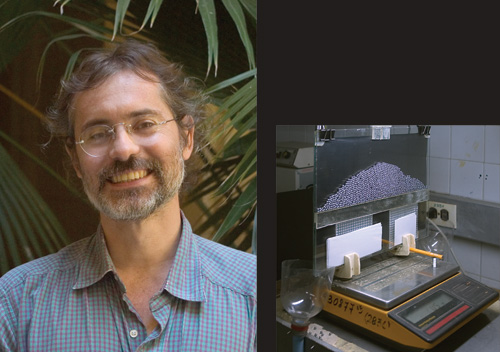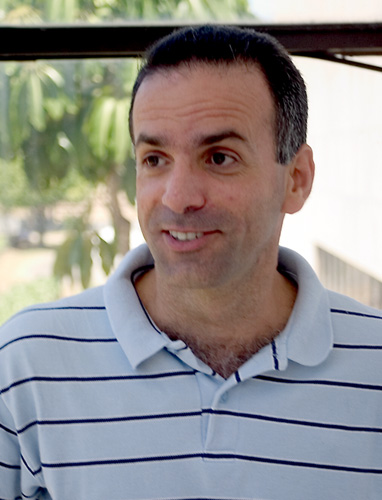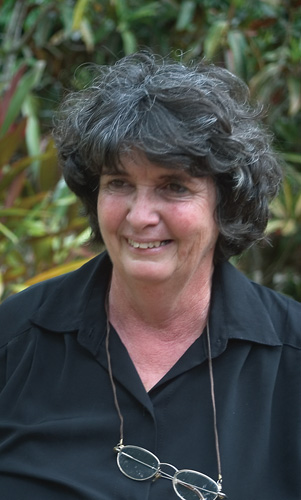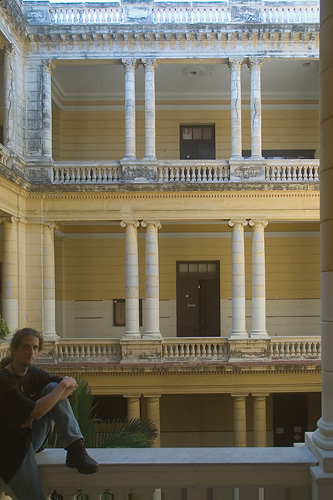Viva La Ciencia
By Rosalind Reid, Brian Hayes
Cuba's creative scientists aim to make knowledge their country's sugar substitute
Cuba's creative scientists aim to make knowledge their country's sugar substitute

DOI: 10.1511/2004.49.0
At first, peas served as particles in Ernesto Altshuler's experiment. A mechanical dispenser would drop the chícharos one by one into the space between two glass plates, forming a tidy two–dimensional approximation of a sandpile. Lattice structure appeared, then vanished, as the pile self-organized and went critical--avalanche!
But Havana's insects soon found the peas in Altshuler's physics lab. "I began to have too many degrees of freedom," he recalled with a smile.

Brian Hayes
For a physicist working under the harsh economic conditions of Cuba in the early 1990s, options were few. Yet Altshuler's solution came as a byproduct of the crisis: Because of fuel shortages, the country had begun importing Chinese bicycles, and ball bearings were available in abundance. Thus the peas have been replaced by steel beads, but Altshuler and his students still call their machine the chicharotron.
Forty-five years after Cuba's revolution, and a decade after the loss of economic support from the U.S.S.R., Altshuler and other scientists of his generation stubbornly and inventively carry on basic and applied science as well as the education of students from Cuba and neighboring countries. Their work is constrained by continuing personal hardship, the whims and troubles of a dictatorship, and a U.S. embargo that impedes access to computer software and laboratory equipment and supplies as well as meetings, fellowships, collaborations and opportunities to publish research. Just before the latest tightening of the U.S. embargo this summer, American Scientist visited Havana to talk with some Cuban scientists about their work, which because of these barriers is less well known in the U.S. than it might be.
In proportion to the size of its national economy, Cuba invests more in science and engineering than its Latin American neighbors, except Brazil, and far more than developing countries in general, according to 2002 statistics from the Network on Science and Technology Indicators. A 2001 RAND report for the World Bank rated Cuba "scientifically proficient" on the basis of its high relative investment and number of scientists and engineers. Despite the economic and political constraints under which it operates, Cuban science has an unusual vibrancy. The country's high literacy rate and the Castro government's emphasis on science and investment in training feed bright students into a research-and-development enterprise that remained a source of pride during the island nation's worst years.
"The important thing is to have the people," said Sergio Jorge Pastrana, who oversees international relations for the Cuban Academy of Sciences. "Money comes afterward."
Altshuler is one of the human assets Cuba has succeeded in keeping. Adecade ago, he was working on superconducting materials, studying"avalanches" of vortices moving through a crystal lattice. Butexperiments on superconductivity were impractical in Havana. (For onething, there was no liquid helium for refrigeration.) To continue in thesame line of work would have entailed spending much of his time abroad,or else confining himself to theoretical studies.
He chose instead to make a career out of "experiments doable in Cuba," whatever they might be. Avalanches of various kinds remain a central theme, investigated not only with peas and ball bearings but also with Cuba's considerable variety of beach sands. (He has recently discovered a new phenomenon in sandpile physics, in which "rivers" of sand rotate around the pile.) He also has a long-running experiment on seismic instability, in which the apparatus consists of a salvaged strip–chart recorder and a handful of tiny magnets from Radio Shack. Even the local abundance of insect wildlife, which plagued the chicharotron, has been turned to good effect: Altshuler has been looking into the "physics" of panicked ants in a Petri dish.
Osvaldo de Melo and Maria Sánchez are husband and wife as well as dean and vice–dean of the Havana physics faculty. Their interests lie in condensed–matter physics, in fabricating semiconductor devices, magnetic materials and the like—the kind of work often done in a gleaming white cleanroom by technicians in lint–free bunny suits. The laboratories in Havana never approached that standard, but through the 1980s it was still possible to do competitive solid–state research. Much of the apparatus was Russian–made, including the department's prize possession: a molecular–beam epitaxy (MBE) machine for depositing thin layers under precise control. The MBE device is still there in a basement room, its stainless steel vacuum vessel cradled amid ducts and tubes and wires, but inoperable without spare parts and supplies. Much other equipment is kept in working order only through improvisation.
Improvisation, in fact, is a theme of Cuban science and life. Sánchez has completed crucial steps in some of her experiments during visits to better–equipped laboratories overseas. She has also resorted to computer simulation in lieu of the lab bench. de Melo has adopted the "mother of invention" approach: Lacking access to MBE equipment for making thin–film devices, he has turned to research on low-tech, low-cost ways of accomplishing the same thing. He reports promising results using sublimation in a simple quartz-lined oven. These varied strategies have kept Sánchez and de Melo active and publishing, but they have also limited the scope of their work. Studies of material properties are feasible, but not fabrication of complex devices.
In the U.S., debates about the level of support for science tend to focus on research grants and departmental budgets, but in Cuba it gets more personal. Sánchez points out that the monthly salary of a senior member of the faculty is 600 pesos, equivalent to about $23. Although many basic services are supplied at little or no cost, this is not nearly enough to support a family. Thus the issue for many Cuban scientists is how to keep teaching and doing research while also scrambling to make a living in some other way. Fellowships and visiting professorships in Europe and Latin America have become increasingly important not just as opportunities to collaborate with foreign colleagues but simply as a means of acquiring hard currency.
Things are rather different out at the "Scientific Pole" on Havana's western edge, where modern facilities house the research, development and pilot-production facilities that fuel Cuba's biotechnology effort. Here Ernesto Moreno welcomes his visitors to the Center of Molecular Immunology (CIM) with a marketing video that touts the monoclonal antibodies, vaccines and other products developed at the Pole.

Brian Hayes
Educated in Moscow as a nuclear physicist when the country was attempting to launch a nuclear power program, Moreno was ready to apply his quantitative skills to genetics when the nuclear project was abandoned in 1992. He went to Sweden for a Ph.D. in structural biology and today works in molecular modeling at the CIM, where cleanrooms and bunny suits are indeed standard. Three decades into Cuba's ambitious biotechnology push, biomedical product sales fund national health care, Moreno notes; additional revenues, Pastrana said, are invested in education and the research effort itself. Joint ventures have been negotiated with China, India, Malaysia, Vietnam, Germany and other countries possessing the capital to build plants and license production techniques and distribution rights from Cuba—or the ability to conduct clinical trials that will win acceptance for Cuban drugs in affluent nations.
Biology, Pastrana points out, can be done with more limited resources than physics. Among Cuba's available assets are its natural resources, not just sugar cane and tobacco but an array of wildlife said by some to be unusually well preserved because of the island's underdevelopment.

Brian Hayes
Twenty–five kilometers south of central Havana, botanist Rosalina Berazain has had the run of a grand laboratory since her student days more than 30 years ago. The National Botanical Garden has specimens of much of the nation's 6,500 vascular flora (half the species of the entire Caribbean). Berazain is one of 10 professors from the university who train young conservationists at the National Botanical Garden for work in regional protected areas around the island. Although Berazain lacks facilities to do the genetic analysis that undergirds taxonomy and conservation today, she has field laboratories to offer to overseas collaborators. In return, a botanical garden in Berlin performs molecular analysis on her specimens.
Much of Cuban science has the strongly pragmatic emphasis typical of developing–country research programs. For some years talented students have been steered toward the biotechnology sector, and now they are being enticed by a new initiative in informatics. (Still more young people are lured away by the tourist industry, which has the important inducement of offering dollars rather than pesos.)

Brian Hayes
But basic science has survived in Cuba, and recently it has been singled out for encouragement and new financial support. Last January, the Ministry of Science, Technology and Environment announced a new series of competitive grants for research in basic sciences and mathematics. Although the amount of money is small--20 million pesos, or about $750,000, spread over five years--it represents "official recognition at the highest level," as one mathematician remarked, a phrase that all Cubans recognize as referring to Fidel. At least eight of the new grants will go to workers at the Institute for Cybernetics, Mathematics and Physics, which occupies several large, colonial–era houses scattered around a neighborhood near the university. The institute has programs in quantum physics, cosmology, linear algebra, statistics and geometry, among other areas.
American visitors tend to see Cuban affairs through the lens of American foreign policy. The long trade embargo and travel restrictions surely have had profound effects on everyday life in Havana, and yet the event seared most deeply into the memories of Cubans is the dissolution of the U.S.S.R., the subsequent withdrawal of Soviet support and the collapse of living standards that followed.
Still, the embargo does give an edge to the stories Cuban scientists tell visiting U.S. journalists. When Pastrana, a historian of science, received a shipment of journal issues on CDs from an American publisher, every disk had been broken. Maria Sánchez was the president of the Havana chapter of the Institute for Electrical and Electronic Engineers; in 2002 she received a letter from the IEEE severing connections with the chapter and denying support, services and privileges to individual members. The letter said the actions were taken to "comply with U.S. government restrictions." Altshuler had been planning to visit the Santa Fe Institute--his third trip to the U.S.--but his visa application was denied.
Science goes on regardless. On a Friday afternoon toward the end of the academic term, students filed into the lecture hall of the physics department for presentations of undergraduate research, followed by an awards ceremony. In many respects, the scene could have been at any American university. Students in the audience cheered friends and classmates; departmental rivalries flared up; at one point the computer running the PowerPoint presentations had to be rebooted.
But there was also an intensity to the proceedings that seemed distinctly Cuban. The young speakers were cross–examined, and a debate erupted in the audience, bouncing back and forth between students and faculty. Subtleties of quantum mechanics were argued with the same urgency and passion as the merits of contending baseball teams. These young men and women, already zealously engaged in the rituals and traditions of the scientific community, face uncertain career prospects. But for a moment it seemed possible to be optimistic about a vision of Sergio Pastrana's: "Eventually, Cuba could live off knowledge instead of sugar."
Click "American Scientist" to access home page
American Scientist Comments and Discussion
To discuss our articles or comment on them, please share them and tag American Scientist on social media platforms. Here are links to our profiles on Twitter, Facebook, and LinkedIn.
If we re-share your post, we will moderate comments/discussion following our comments policy.